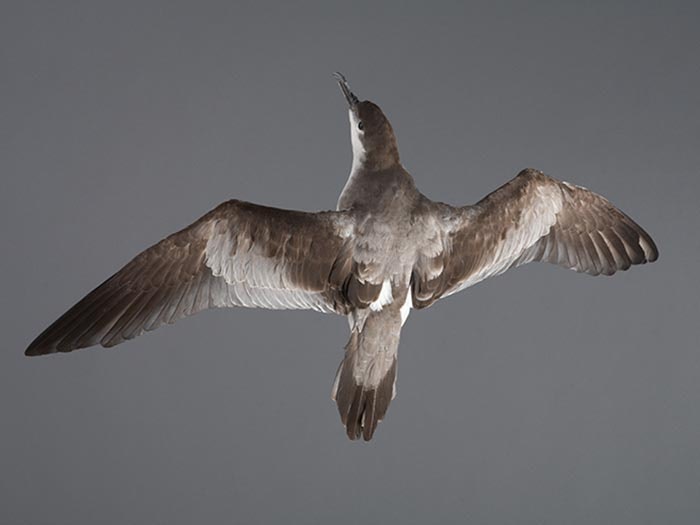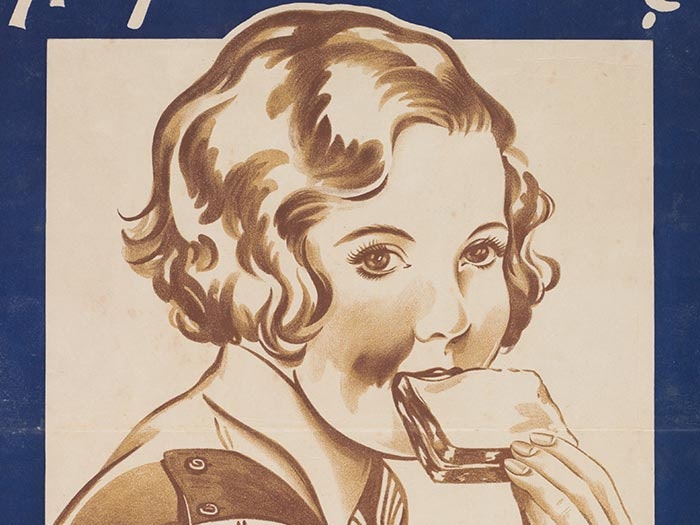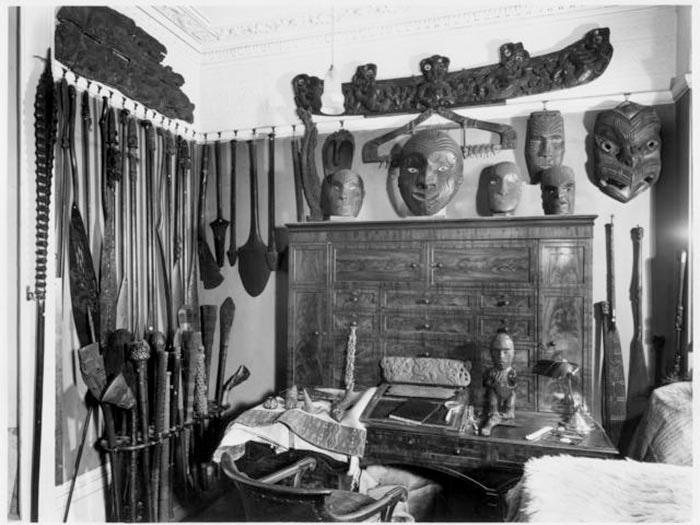
Tuhinga 24, 2013
Full Tuhinga issue 24 (7.13 MB)
Or download the individual article you're interested in below.
Obituary: John Munne Moreland (1921–2012). John (Jock) Moreland, a marine biologist with a long career at the Dominion and later National Museum, was known for his enthusiasm for popularising science and passing on his knowledge on to young naturalists.
Go to Obituary: John Munne Moreland (1921–2012)
Archaeological excavations at the Station Bay pā, Motutapu Island, inner Hauraki Gulf, New Zealand reports on excavations of the pā at Station Bay on Motutapu Island, near Auckland, a site of considerable archaeological research for more than 50 years due to its largely intact pre-European cultural landscape.
Go to Archaeological excavations at the Station Bay pā, Motutapu Island, inner Hauraki Gulf, New Zealand
Rites of passage: public response to Don Driver’s Ritual (1982) and its institutional history examines this controversial work, which has been the subject of intrigue, anger and confusion for New Zealand audiences since it production. The article looks at public responses to the work over time and its continuing iconic status.
Go to Rites of passage: public response to Don Driver’s Ritual (1982) and its institutional history
The Mixing Room project at Te Papa: co-creating the museum with refugee background youth in Aotearoa/New Zealand examines this collaborative exhibition, discussing the project’s methodologies, aims, challenges and outcomes.
Go to The Mixing Room project at Te Papa: co-creating the museum with refugee background youth in Aotearoa/New Zealand
Polyvocal Tongan barkcloths: contemporary ngatu and nomenclature at the Museum of New Zealand Te Papa Tongarewa discusses five ngatu (Tongan barkcloths) in terms of their material qualities, cultural and curatorial narratives, and how the terms now used to describe and differentiate between varieties of ngatu offer insights into how they are valued or conceptualised.
Go to Polyvocal Tongan barkcloths: contemporary ngatu and nomenclature at the Museum of New Zealand Te Papa Tongarewa
Collecting, exhibiting and engaging with East Polynesia at the Museum of New Zealand Te Papa Tongarewa examines significant artefacts in Te Papa’s collection from the islands of East Polynesia, including historical associations with the eighteenth-century voyages of James Cook and the collecting of William Oldman. It outlines some instances of their display and Te Papa’s outreach and engagement with the communities from this region.
Go to Collecting, exhibiting and engaging with East Polynesia at the Museum of New Zealand Te Papa Tongarewa
The 'Smiling Boy' Health stamps of 1931 examines two New Zealand stamps used to raise funds for public health camps, considering their design, aesthetics and iconography, as well as the political and cultural contexts of economic depression.
Go to The 'Smiling Boy' Health stamps of 1931
Population sizes of shearwaters (Puffinus spp.) breeding in New Zealand, with recommendations for monitoring provides a review of data for Puffinus shearwaters that nest in the New Zealand region, revealing some trends and total population sizes. The authors also note a lack of robust information and make recommendations for future monitoring.
Go to Population sizes of shearwaters (Puffinus spp.) breeding in New Zealand, with recommendations for monitoring
Obituary: John Munne Moreland (1921–2012)
Alan Baker, Jack Garrick
John (Jock) Moreland was born in Wanganui in 1921, where he grew up and attended school. In 1950, after serving with the 3rd New Zealand Division in the Pacific and the 2nd Division in Italy during the Second World War, Jock joined the staff of the Dominion Museum (now the Museum of New Zealand Te Papa Tongarewa).
Obituary: John Munne Moreland (1921–2012) (133.13 KB)
Archaeological excavations at the Station Bay pā, Motutapu Island, inner Hauraki Gulf, New Zealand
Janet Davidson
Excavations at the Station Bay pā on Motutapu in 1970–71 revealed a complex sequence, from a relatively extensive open settlement to a more compact fortification between about AD 1500 and 1800. Charcoal analysis portrays a largely scrub-covered landscape with only a few trees. Food-storage pits and faunal remains reflect a subsistence economy based on kūmara (sweet potato) cultivation and the harvesting of marine resources: shellfish from the adjacent rocky shore and both protected and exposed sandy beaches, and fish, predominantly snapper, from fishing grounds nearby. The few items of material culture are typical of Māori assemblages of the time.
Archaeological excavations at the Station Bay pā, Motutapu Island, inner Hauraki Gulf, New Zealand (2.91 MB)
Rites of passage: public response to Don Driver’s Ritual (1982) and its institutional history
Sarah Farrar
For 30 years Don Driver's artwork Ritual (1982), from Te Papa's collection, has intrigued, angered and confused audiences. This text analyses documentation of the public response to the work and its institutional history from 1982 to 2012, and considers the impact of this chequered history upon Ritual's iconic status within New Zealand art.
Rites of passage: public response to Don Driver’s Ritual (1982) and its institutional history (1.70 MB)
The Mixing Room project at Te Papa: co-creating the museum with refugee background youth in Aotearoa/New Zealand
Stephanie Gibson, Sara Kindon
The Museum of New Zealand Te Papa Tongarewa (Te Papa) represents the diverse cultures of New Zealand through community exhibitions. The Mixing Room: stories from young refugees in New Zealand is the museum's sixth community exhibition and focuses on young people from refugee backgrounds and their stories of resettlement.
The Mixing Room project at Te Papa: co-creating the museum with refugee background youth in Aotearoa/New Zealand (1.76 MB)
Polyvocal Tongan barkcloths: contemporary ngatu and nomenclature at the Museum of New Zealand Te Papa Tongarewa
Billie Lythberg
The Museum of New Zealand Te Papa Tongarewa (Te Papa) collects and exhibits Tongan barkcloth (ngatu) to illustrate curatorial narratives about Pacific peoples in New Zealand. I discuss the materiality and provenances of five ngatu at Te Papa, their trajectories into the museum’s Pacific Cultures collection and, where relevant, how they have been exhibited. I consider the role of Tongan curators and communities in determining how, when and which ngatu will enter the collection, and how Tongan identity will be imaged by the objects. The paper concludes with a close examination of contemporary descriptive and evaluative nomenclature for ngatu made with synthetic materials, including examples at Te Papa.
Polyvocal Tongan barkcloths: contemporary ngatu and nomenclature at the Museum of New Zealand Te Papa Tongarewa (1.40 MB)
Collecting, exhibiting and engaging with East Polynesia at the Museum of New Zealand Te Papa Tongarewa
Sean Mallon, Grace Hutton
The Pacific Cultures collection of the Museum of New Zealand Te Papa Tongarewa (Te Papa) holds significant artefacts from the islands of East Polynesia, including the Austral Islands, Society Islands, Marquesas Islands, Tuamotu Archipelago, Pitcairn Island and Rapa Nui (Easter Island).
Collecting, exhibiting and engaging with East Polynesia at the Museum of New Zealand Te Papa Tongarewa (3.35 MB)
The 'Smiling Boy' Health stamps of 1931
Mark Stocker
The 'Smiling Boy' pair of New Zealand stamps, named after the youth depicted on each value, was issued in 1931. The stamps carried a 1d (one penny) premium on their postage to raise funds for the burgeoning health camp movement. They bridge the gap between their charity stamp predecessors and the Health stamps of the future. The article considers their design, aesthetics and iconography, locating the stamps within their political and cultural contexts at a time of economic depression. The Museum of New Zealand Te Papa Tongarewa has significant holdings of 'Smiling Boys' material, including Royal Mint die proofs and official correspondence, as well as specimens of the stamps and the promotional poster. These are among the sources utilised in this paper.
The 'Smiling Boy' Health stamps of 1931 (4.68 MB)
Population sizes of shearwaters (Puffinus spp.) breeding in New Zealand, with recommendations for monitoring
Susan Waugh, Alan Tennyson, Graeme Taylor, Kerry-Jayne Wilson
We reviewed population data for the nine taxa of shearwaters Puffinus spp. that nest in the New Zealand region. Data for about 350 current breeding colonies were found, and each taxon nested at between three and about 180 localities. We reviewed the information to assess time-series of information for each population and, where possible, to determine trend and total population size. However, few of the species had robust enough information to allow those assessments to be made. We recommend high-priority sites for future monitoring, and encourage other researchers to publish or make available findings from previous work to assist in building a comprehensive picture of the status of shearwater populations.
Population sizes of shearwaters (Puffinus spp.) breeding in New Zealand, with recommendations for monitoring (253.19 KB)

